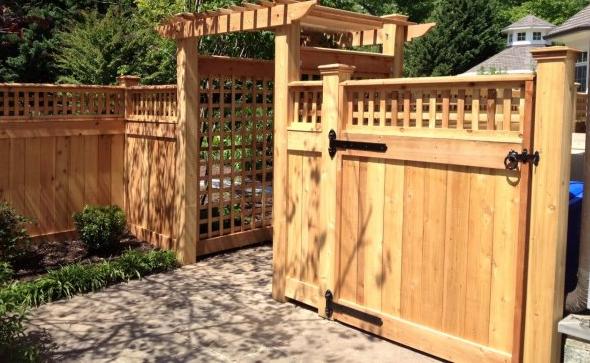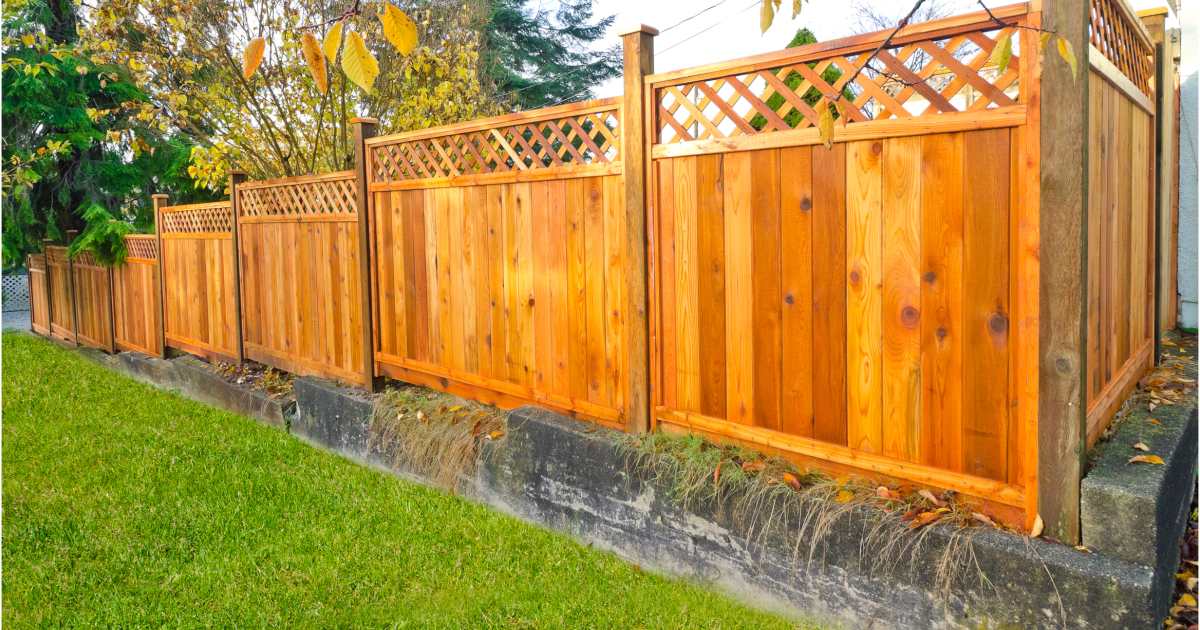All Categories
Featured
Your fence is exposed to numerous weather year-round, and while it functions as an important part of your residential property, it's likewise one of the most vulnerable elements when it comes to weather-related damage. Harsh winds, heavy rainfall, extreme temperatures, and UV exposure can all take a toll on your fencing's stability, resulting in tear and use. Thankfully, there are a couple of steps you can require to secure your fencing and lengthen its life expectancy. Here are some reliable methods to guard your fencing from weather-related damages.
Wood Fencings: While wood is a timeless selection for secure fencing, it is prone to bug, warping, and rot damages, particularly in locations with high dampness. Pressure-treated wood or cedar is much more long lasting, but routine upkeep is important to keep it in great problem. Plastic Fence: Vinyl is an excellent option for those seeking a low-maintenance and weather-resistant fencing. It's impervious to wetness, will not warp or fracture in the heat, and withstands fading from UV rays. Steel Fencing: Wrought iron and light weight aluminum are long lasting materials for secure fencing, however they need a rust-resistant finish to secure them from corrosion due to wetness. A protective finish or routine maintenance can avoid rust and extend the life of metal fences. Compound Fence: Made from a mix of wood fibers and plastic, composite fences are highly immune to weather components, consisting of wetness, warm, and UV rays. This material offers a balance of resilience and visual appeal. Picking a product fit to your environment will certainly give better defense for your fencing in the lengthy term.
Seal or Discolor the Timber: Using a top notch sealant or stain to your timber fencing creates a water resistant barrier that prevents dampness from getting in the timber. It also aids protect the wood from UV rays, which can trigger discoloration and drying. Reapply Sealer Regularly: Over time, the safety obstacle of your sealer or discolor can wear down. Relying on your climate, it's a good concept to reapply each to two years to maintain the wood safeguarded. This treatment will protect the fencing's look, prevent rot, and lengthen its lifespan.
![]()
For additional security, take into consideration utilizing wind-resistant mesh displays or panels in areas where wind is a substantial worry. This additional layer can help lessen the pressure that the wind exerts on your fencing.
Examine Drain: Ensure that the ground around your fencing inclines far from the messages. Proper drainage enables water to stream far from the fencing, preventing dampness accumulation. Mount Drainage Solutions: In areas where drain is an issue, think about including a French drain or crushed rock around the base of your fencing blog posts to reroute water far from the framework. Good drain can protect against rot, rust, and other types of weather-related wear and tear.
![]()
![]()
Concrete Footings: Establish fence blog posts in concrete to prevent them from loosening up gradually due to soil disintegration or moving ground. Metal Braces: Adding steel dental braces to fencing posts can offer added stamina and reduce the danger of breaking or leaning. Reinforcing your articles makes sure that your fencing will stay in location, even during serious weather.
For wooden fences, carefully wash the surface area with a mild cleaning agent to remove dust and crud. For plastic fences, use a soft cloth and cleaning solution to stop build-up. For steel fencings, check for corrosion and sand it off prior to applying a fresh layer of paint. Verdict. Your fence is an essential feature of your building, and with the best care, it can hold up against the obstacles posed by the weather condition. By selecting sturdy products, doing routine maintenance, and enhancing powerlessness, you can secure your fencing from the components and expand its life. Regular assessments, using safety layers, and taking actions to control wetness and wind direct exposure will certainly help ensure that your fence continues to be strong, practical, and eye-catching for many years ahead.
- Select Weather-Resistant Materials. The products you select for your fencing can have a significant influence on its capability to endure the elements. Different materials are much better geared up to manage details climate condition. Here's a malfunction of just how numerous materials stand up against the climate:
Wood Fencings: While wood is a timeless selection for secure fencing, it is prone to bug, warping, and rot damages, particularly in locations with high dampness. Pressure-treated wood or cedar is much more long lasting, but routine upkeep is important to keep it in great problem. Plastic Fence: Vinyl is an excellent option for those seeking a low-maintenance and weather-resistant fencing. It's impervious to wetness, will not warp or fracture in the heat, and withstands fading from UV rays. Steel Fencing: Wrought iron and light weight aluminum are long lasting materials for secure fencing, however they need a rust-resistant finish to secure them from corrosion due to wetness. A protective finish or routine maintenance can avoid rust and extend the life of metal fences. Compound Fence: Made from a mix of wood fibers and plastic, composite fences are highly immune to weather components, consisting of wetness, warm, and UV rays. This material offers a balance of resilience and visual appeal. Picking a product fit to your environment will certainly give better defense for your fencing in the lengthy term.
- Regularly Treat Wooden Fencings. Protecting it from sunlight, temperature, and dampness variations is essential if you have a wood fence. Timber can absorb dampness from rainfall, snow, or humidity, creating it to rot and deteriorate. Here's just how you can protect wooden fences:
Seal or Discolor the Timber: Using a top notch sealant or stain to your timber fencing creates a water resistant barrier that prevents dampness from getting in the timber. It also aids protect the wood from UV rays, which can trigger discoloration and drying. Reapply Sealer Regularly: Over time, the safety obstacle of your sealer or discolor can wear down. Relying on your climate, it's a good concept to reapply each to two years to maintain the wood safeguarded. This treatment will protect the fencing's look, prevent rot, and lengthen its lifespan.

- Set up Windbreaks. Strong winds can trigger substantial damages to fencings, especially those made of light-weight products or high frameworks. These all-natural obstacles can help deflect wind, stopping straight gusts from damaging your fence.
For additional security, take into consideration utilizing wind-resistant mesh displays or panels in areas where wind is a substantial worry. This additional layer can help lessen the pressure that the wind exerts on your fencing.
- Make Sure Proper Drain Around Your Fencing. Standing water is one of the leading sources of fence damage, especially for wood fences. Water can compromise the fencing blog posts, triggering them to rot and degrade quicker. To stop this:
Examine Drain: Ensure that the ground around your fencing inclines far from the messages. Proper drainage enables water to stream far from the fencing, preventing dampness accumulation. Mount Drainage Solutions: In areas where drain is an issue, think about including a French drain or crushed rock around the base of your fencing blog posts to reroute water far from the framework. Good drain can protect against rot, rust, and other types of weather-related wear and tear.

- Trim Overhanging Branches and Vines. Trees and plants near your fencing may appear like an attractive enhancement, but they can position threats when left untreated. Overhanging tree branches and creeping plants can trigger damage to your fencing throughout tornados or high winds. Additionally, creeping plants can catch moisture versus wood fencings, quickening the rotting process. To protect your fencing, trim any type of branches or plants that hang over or near the fencing on a regular basis. This will lessen the opportunity of falling debris and prevent moisture buildup.
- Reinforce Fence Posts. Fencing messages are prone to changing, leaning, and decaying, particularly during periods of extreme climate. If your fencing is in a location that ices up or experiences high winds throughout winter, it's vital to reinforce the blog posts to keep security.

Concrete Footings: Establish fence blog posts in concrete to prevent them from loosening up gradually due to soil disintegration or moving ground. Metal Braces: Adding steel dental braces to fencing posts can offer added stamina and reduce the danger of breaking or leaning. Reinforcing your articles makes sure that your fencing will stay in location, even during serious weather.
- Normal Assessments and Upkeep. Check your fence after storms or heavy rain to look for problems such as loose boards, drooping blog posts, or rusted locations. Additionally, cleansing your fence periodically assists preserve its condition.
For wooden fences, carefully wash the surface area with a mild cleaning agent to remove dust and crud. For plastic fences, use a soft cloth and cleaning solution to stop build-up. For steel fencings, check for corrosion and sand it off prior to applying a fresh layer of paint. Verdict. Your fence is an essential feature of your building, and with the best care, it can hold up against the obstacles posed by the weather condition. By selecting sturdy products, doing routine maintenance, and enhancing powerlessness, you can secure your fencing from the components and expand its life. Regular assessments, using safety layers, and taking actions to control wetness and wind direct exposure will certainly help ensure that your fence continues to be strong, practical, and eye-catching for many years ahead.
Latest Posts
Experience Your Financial Partner at WyHy – Financial Freedom for Your Future
Published May 25, 25
1 min read
Explore Budget-Friendly Auto Repairs with Montclare’s Exclusive Service Specials
Published May 23, 25
1 min read
Find Out Reduce Expenses on Car Maintenance with Montclare Auto Repair’s Limited-Time Deals
Published May 23, 25
1 min read
More
Latest Posts
Experience Your Financial Partner at WyHy – Financial Freedom for Your Future
Published May 25, 25
1 min read
Explore Budget-Friendly Auto Repairs with Montclare’s Exclusive Service Specials
Published May 23, 25
1 min read
Find Out Reduce Expenses on Car Maintenance with Montclare Auto Repair’s Limited-Time Deals
Published May 23, 25
1 min read